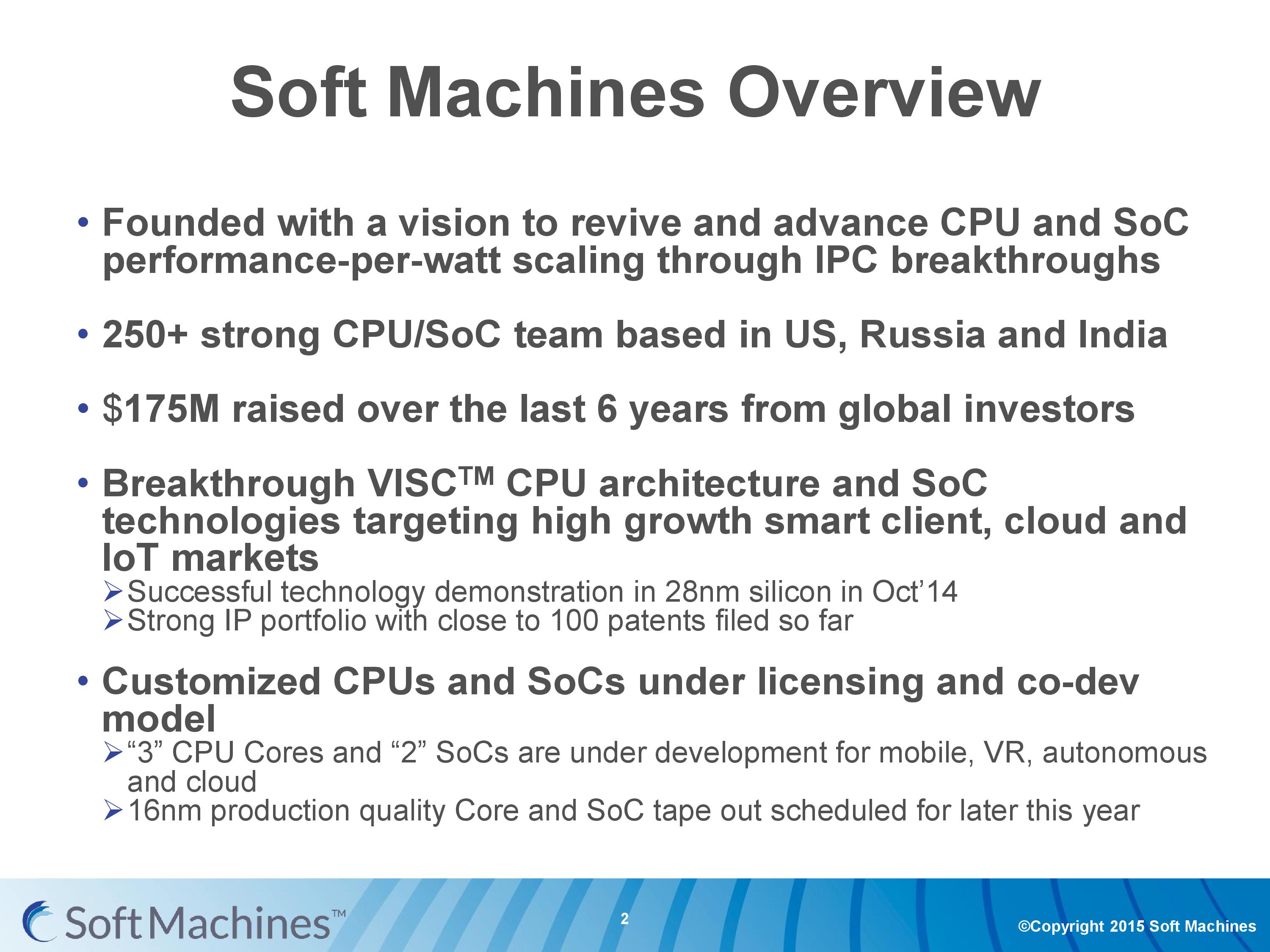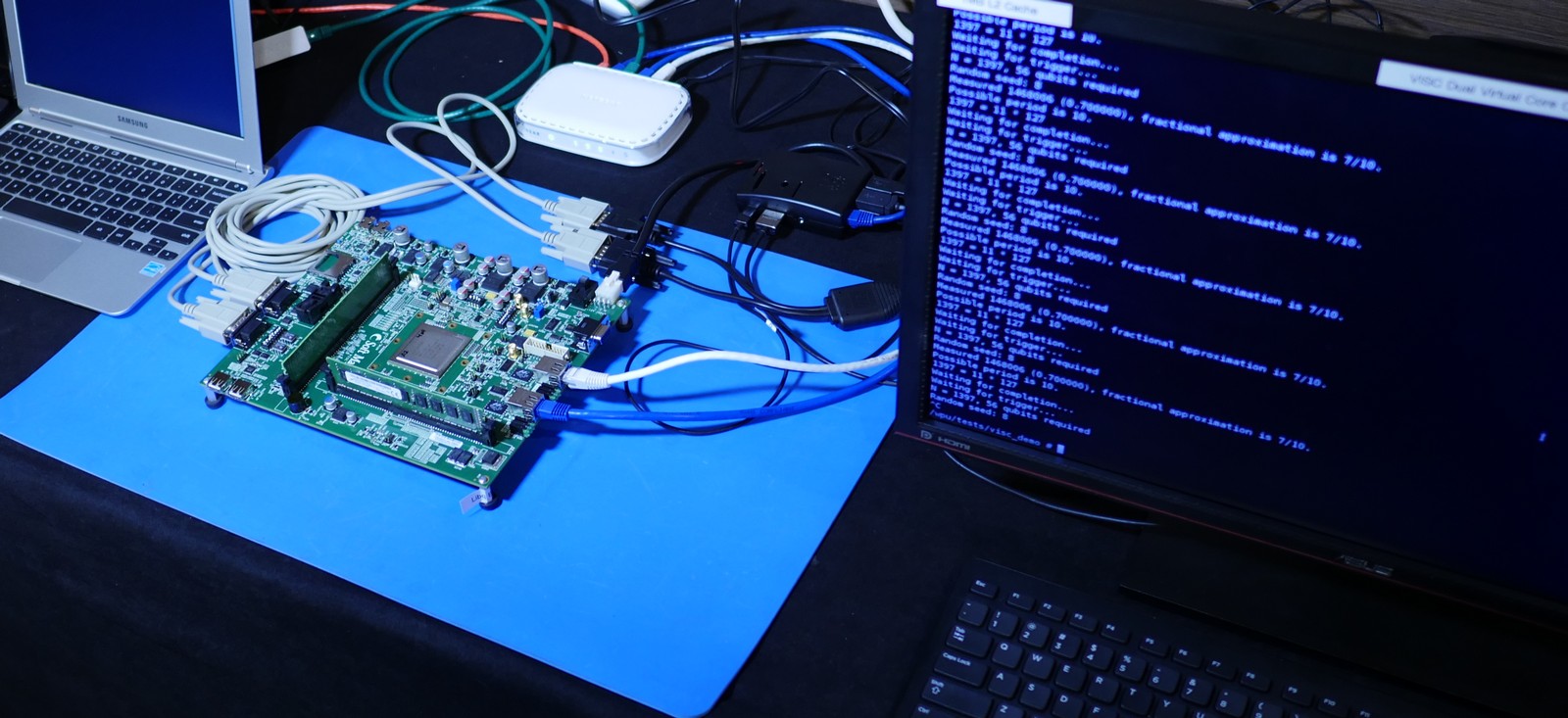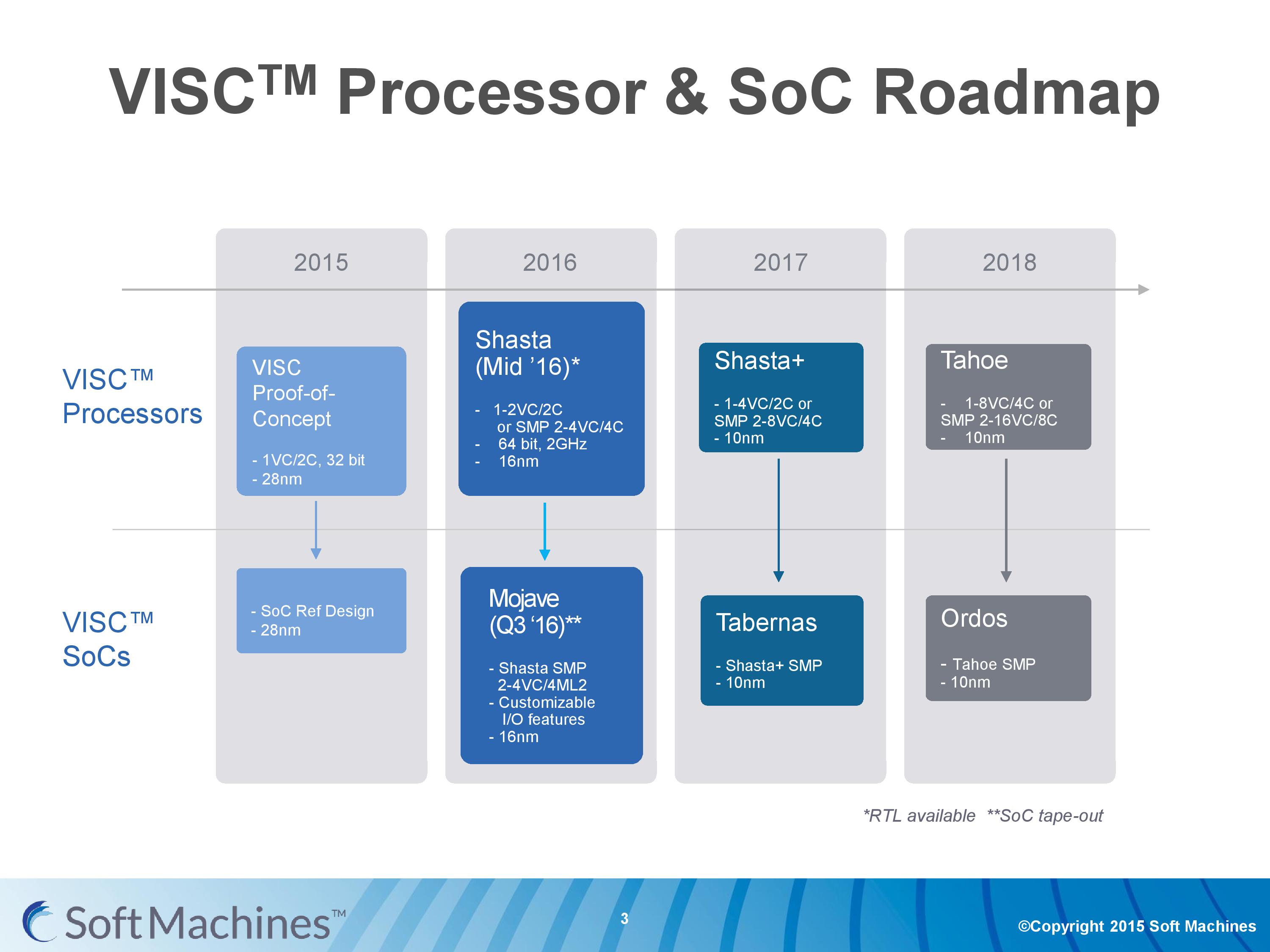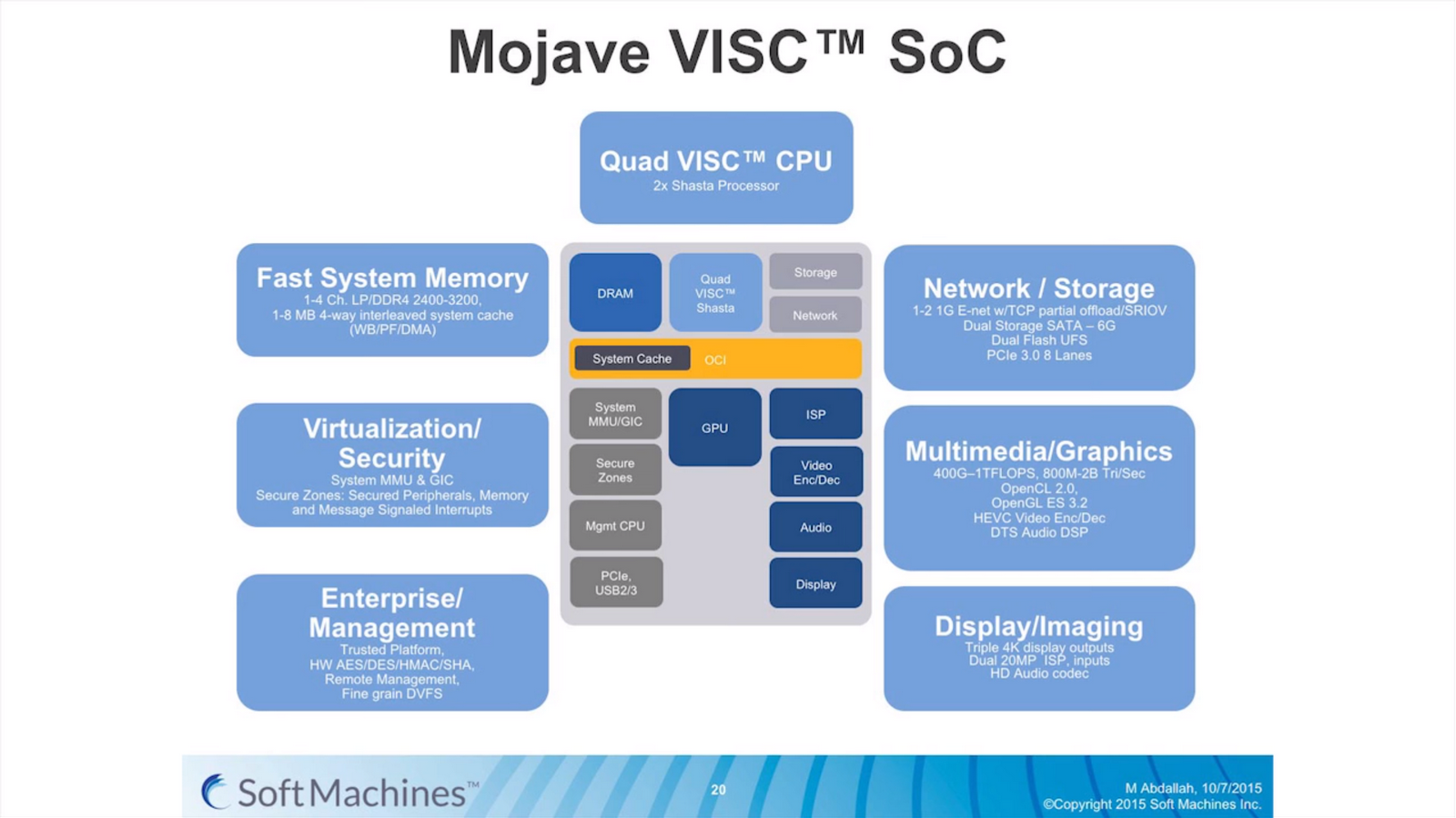Examining Soft Machines' Architecture: An Element of VISC to Improving IPC
by Ian Cutress on February 12, 2016 8:00 AM EST- Posted in
- CPUs
- Arm
- x86
- Architecture
- Soft Machines
- IPC
Soft Machines
To put it succinctly, having a thread take resources from multiple cores - when the performance can be extracted - sounds like the long-desired solution to the problem making multi-core designs more useful in lightly-threaded scenarios. Having multiple threads use resources on a single core on the same clock cycle is an even bigger leap in the same direction. Now obviously Soft Machines didn’t come up with this overnight.
Soft Machines came out of stealth mode at the 2014 Linley Conference. Their main goal was to increase performance-per-watt using better IPC designs, which is often one of the better ways if you can keep a design fed with data. One big challenge to this is that IPC has been somewhat flat these past few years - we're seeing small sub-10% yearly increases from the big players using standard designs. Soft Machines were already six years old at the time, with $150M+ raised from investors that include Samsung Ventures, GlobalFoundries, AMD, Mubadala and others (with another $25M since). If those names all seem interlinked, it’s because they all have historic business or investment dealings with each other (AMD/GloFo, Samsung/GloFo, AMD/Mubadala etc.). The team at Soft Machines is 250+ strong, with ex Intel, ex Qualcomm, ex AMD engineers on staff from processor design to platform architects. Half the staff is currently located in California.
At the 2014 conference, aside from explaining what they were doing, Soft Machines also exhibited working silicon of their design. The first generation proof of concept was fabbed at 28nm at TSMC and running at 500 MHz.
It seems odd to say that it was done at TSMC, especially with Samsung and Global Foundries as investors. We were told that this was due to timing and positioning with IP more than anything else, and the same is true for the next generation at 16nm FF+, rather than 14nm.
VISC and Roadmaps
The first generation chip wasn’t perfect – there were some design flaws in silicon that required specific workarounds relating to cache flushing and various methods, but at the time it was compared to a single thread Cortex A15 running at a similar frequency in a Samsung processor. The results with SPEC2000, SPEC2006, Denbench and Kraken gave a corresponding IPC relative to A15 of 1.5x to 7x, or as Soft Machines likes to put it: 3-4x "on average." It was estimated that access to a second physical core improves performance by an average of 50-60%, or an average IPC of 1.3 per core compared to 0.71 for Cortex A15, which explains the 3-4x average.
The roadmap for Soft Machines put their second generation VISC core, Shasta, in line for 2016. It was formally announced at the 2015 Linley Conference, with this month’s announcement being more about availability for licensing on 16FF+. The Shasta core on this node is designed as a 2C/2VC design, or two of these can be put together using a custom protocol interconnect to form a dual 2C/2VC design.
The custom interconnect fabric here is capable of over 200 GB/s, although in current designs only a single interface is present, allowing only two chips to be connected.
The dual processor design is going to be part of the Mojave IP as a fully integrated SoC.
Along with the requisite VISC cores, the Mojave SoC includes PowerVR graphics, a DDR4 memory controller, virtualization management, a PCIe root complex capable of eight lanes of PCIe 3.0, USB ports, support for SATA, UFS, OpenCL 2.0 and other standards.
Looking forward, Soft Machines would like to see production move to 10nm in 2017 to take advantage of further power and area scaling. Meanwhile along that same timeframe they also want to expand the Shasta design to allow for four virtual cores per two physical cores, essentially allowing more threads to be in flight at one time and fully use the resources better. 2018 sees the move to four physical cores and eight virtual cores per design, while still supporting SMP and SoC designs as well.















97 Comments
View All Comments
tipoo - Friday, February 12, 2016 - link
Pretty interesting stuff. As they open up a bit more and provide more data, I'm cautiously letting myself believe there's a possibility of this taking off, but I'm not budging my optimism meter past 1 until this ships and is positively reviewed.I wonder if it's more likely they'll be bought out first. If Intel sees a credible competitor, that's certainly possible.
willis936 - Friday, February 12, 2016 - link
The prospect of actual single threaded performance increases is exactly what the future of computing needs. I'm not as concerned with the existence of the technology as I am the adoption. Competing with intel is more than just making a good processor. This company will have to convince other companies to integrate a Lot of the controllers and interfaces that intel does for them.easp - Friday, February 12, 2016 - link
If they can actually deliver real single-threaded performance increases, the world will beat a path to their door. On-chip peripherals and off-chip interfaces are cookie-cutter in comparison.Xenonite - Wednesday, February 17, 2016 - link
"If they can actually deliver real single-threaded performance increases, the world will beat a path to their door."Sadly, this is not how the semiconductor industry works. AMD could, for instance, DOUBLE their single threaded integer performance by simply tweaking their ZEN design to utilize 4x~5x the current planned TDP of 95W, using a larger die to spread the increased current load over multiple transistors, double their L1 and L2 cache sizes and to add a low-latency Last Level Cache.
If done before tape-out, AMD can work with the foundry to optimize the transistors' characteristics and operating points, which would easily allow for a doubling in single-threaded throughput.
Even if the raw clock-rate couldn't simply be doubled, they could use the additional power budget to run MUCH more aggressive speculative execution, and to widen their superscalar pipeline to be at least as wide the average instruction pipeline length is long.
Since IPC does not need to be tied to instruction latency, each core could easily complete around 5~6 instructions per clock by having, say, 10~12 fully functional superscalar pipelines (each pipeline can complete any instruction indapendently, without having to rely on shared logic blocks) .
Xenonite - Wednesday, February 17, 2016 - link
Sorry, I submitted the post before I was finished. Basically, it boils down to the fact that no one (other than myself XD) would be willing to pay for such a processor. Even if AMD managed to totally thrash Intel in absolute performance, no one will care. And with no mass consumer support, their shareholders would never approve such a project in the first place.The main reason why VISC is doomed to fail, is quite similar: you simply can not attract investors with raw performance in 2016.
Even if they actually had a ~5x single-threaded performance lead over Intel's fastest consumer desktop chips, they STILL wouldn't get the billions of dollars that they need to do a mass market rollout of their arch.
The whole situation is making me really morbid and depressed; what I wouldn't give to go back to the Pentium 3 days.
Demiurge - Friday, February 12, 2016 - link
16-wide ILP isn't going to be a mass-market solution... most designs are barely using 1.5 instructions per cycle, let alone 4. Given the stellar shift to CPU and then GPU based vector processing... I might be missing something here, but I would say that there are already 16-wide ILP on certain specialized operation that actually benefit, such as video processing for example.Incidentally, does anyone remember Transmeta Code-Morphing Software? If not, look it up...
sonicmerlin - Saturday, February 13, 2016 - link
You didn't even read the fracking article.name99 - Saturday, February 13, 2016 - link
What he's saying (perfectly legitimately) is that- there is a LONG history of companies praising to the skies superficially good ideas which actually turned out not to matter much
- VISC's unwillingness to provide SPECInt numbers, even after being so strongly excoriated about this by the entire tech press and academic world, STRONGLY suggests that what they're peddling does not work the way they claim. It likely provides a great speedup for much FP code (speedup which you can also get by using a GPU, the preferred path of traditional companies), and very little speedup for standard integer code.
The speed at which they claim they can execute also makes one wonder. Even Apple (likely right now the best funded CPU design-house out there, with the simplest target in their sights, working on more or less traditional designs) aims for a major core every two years, with a minor upgrade in between. These guys, with vastly fewer engineers and money, and trying to do something more innovative, believe they can spin a major upgrade every year...
That seems extremely unlikely, so the only real question is: they bullsh*tting only the press/their investors, or are they also bullsh&tting themselves?
Samus - Monday, February 15, 2016 - link
The parallels with Transmetta ring a bell with me, too, and yes, I did read the article. I'm inclined to have a immature capitalist response to things like this, specifically: if a company as big as Intel, with some of the best engineers in the world who are often open to radical ideas, haven't bothered trying an instruction decoder, it is likely because the pros did not outweigh the cons. After all, Jackson technology (hyper threading) is some form of what's going on here, just not targeting specific requests.Azethoth - Wednesday, February 17, 2016 - link
Agreed, and reading the list of unanswered questions it sounds a lot like they are trying to look good in very specific circumstances, rather than being naturally best in class. The competition is GPU + CPU cores. Unless you prove superiority despite all the tricks the competition has available you cannot succeed. What they propose sounds like it needs to break down the normal inter core separation that lets them operate independently so that they can realize single threaded speedup. I am not an EE, so I assume it is at least possible. I am not sure it can be done practically though.